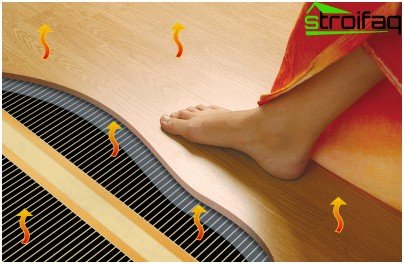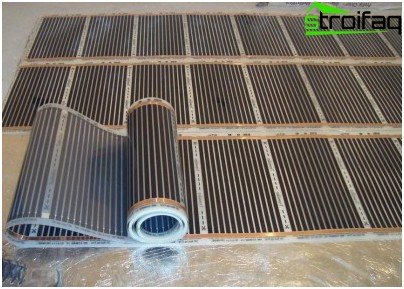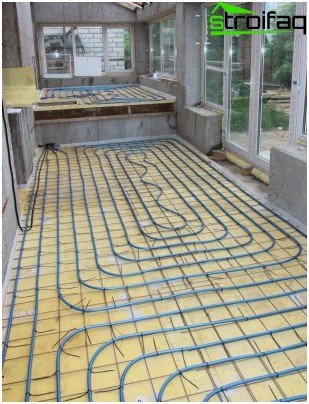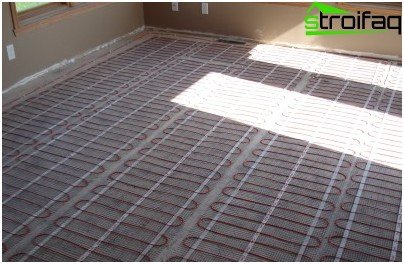What warm floor can be laid under a parquet board
The issue of heating a home has always been relevant for a person, because heat creates a comfortable and cozy atmosphere in a room, and a warm floor under a parquet board cannot but please on cold winter days. However, its device should be approached with particular care, due to the characteristics of the flooring..
Content
- Do I need heating under the floorboard?
- We select the optimal system
- Infrared floors and parquet board
- Water floor heating
- Electric type for parquet board
Do I need heating under the floorboard?
If you have chosen parquet as the floor covering for your house or one of its rooms, then do not forget for a moment that it is natural wood. Remember this when you carry out wet cleaning, open wide the windows, letting the gentle sun rays into the house. Why is this so important? The fact is that wood is an extremely sensitive material to external influences. Failure to comply with the rules of operation of the parquet floor can quickly reduce your efforts to lay it to nothing.
Too much air and high temperatures cause drying. parquet board, waterlogging – to darkening, the formation of mold, the multiplication of fungi and deformation.

The heat-insulated floor is a comfort and cosiness in your house
Moreover, wood is a fire hazardous material. Again, the question arises, but what is the relation to the properties of a parquet board has a warm floor? The answer is quite simple. Underfloor heating under a parquet board is a constant or periodic increase in the temperature of the floor covering and the surrounding air, and a decrease in its humidity level. Of course, this has a negative effect on wood. To preserve the pristine attractive appearance of the flooring, you will have to carefully monitor the temperature and humidity conditions in the room. Otherwise, you risk just “throwing money away”.
It is worth noting that parquet is a good insulating material and perfectly retains heat. That is why, even on winter days, you will not experience discomfort when walking barefoot on the floor..
Thus, before you spend your own money, precious time and non-repairing nerve cells, think well, is there a need for laying a warm floor under the parquet? Are you ready to care for your flooring with due care? If you answered “yes” to both questions, then you can safely begin to study the market of warm floors.
We select the optimal system
Today, both domestic and foreign manufacturers are widely represented on the floor heating market. However, all the products offered can be easily divided into three main types. So, modern warm floors under a parquet board can be:
- film infrared;
- water;
- electric.
Each of these types has a number of operational characteristics, has its own advantages and disadvantages. Read them before you make your choice..
Infrared floors and parquet board
Infrared underfloor heating is a novelty in the corresponding market segment, however, it has already managed to win the love of consumers and receive favorable reviews from specialists. It is arranged quite simply – it is an ordinary polymer film of small thickness, into which graphite strips are soldered in a certain order. Between themselves, these heating elements are connected by materials made of copper or silver, which are characterized by low electrical resistance.
Such a floor is connected via a thermostat to the mains.
The principle of operation of this type of warm floor is also simple: heating elements give off thermal energy to the infrared range of the floor surface and objects standing on it. It is the heated interior items that then give off heat to the surrounding air. This is a distinctive feature of the infrared film floor. When using other systems, the surrounding air first heats up, and only then objects in the room heat from its heat.
Remember: parquet board is a delicate material. That is why when using a film underfloor heating, it is not recommended to heat the parquet more than by 27˚C. If it has a varnish coating, then the optimum temperature will be 21˚C.

Film infrared floor for parquet board
Infrared warm floor has a lot of advantages:
- It fits any fine floor covering..
- It is distinguished by its flexibility, which allows it to be laid on a sloping surface, steps, podiums.
- If one section of the warm floor fails, the rest of the canvas will work as usual.
- It can be used for several decades..
- Floor heating occurs within a few minutes after turning on the system.
- IR film floor is absolutely safe for children, adults and pets.
Water floor heating
This type of floor heating as a heating element involves the use of ordinary water. It fills plastic pipes laid in a certain way on the floor base and poured with concrete screed. Hot water underfloor heating is often used as the main source of heat in small rooms, however, if there is parquet flooring, it is better not to ignore traditional radiators.
Underfloor heating cannot be installed in an apartment of a multi-storey building with central heating, since the use of electric energy to heat water in floor pipes is prohibited.
The main advantages of a water floor include the following:
- It is great for heating large areas..
- Saves energy.
- Floor and air heating is as even as possible.

Water heated floor under the parquet board
As for the shortcomings of this system, you will have to consider the following nuances:
- No one is safe from accidents and leaks, which means that water can damage an expensive parquet board.
- To regulate the mode of operation of a water heated floor is somewhat more difficult than electric or film infrared.
- You can’t do without the services of a wizard when installing the system.
- The design of this type of underfloor heating will steal from the existing ceiling height of about 11-13 cm.
Electric type for parquet board
Electric underfloor heating is quite widely used in modern residential premises. It has a fairly affordable price and efficient work. The heating element in this case is the electric heating cable. It can be laid on a previously prepared floor base in two main ways: spiral and parallel.
The cable can be separate or sealed in a film. In the latter case, an electric heat-insulated floor, like a film infrared analogue, can be laid on a complex surface. After laying the cable, the insulation is laid and the concrete screed is poured.
The heating cable acts as a converter of electrical energy into heat.
The advantages of an electric warm floor include:
- Easy installation – even a layman can handle it.
- No negative impact on the parquet flooring with proper temperature control, the absence of any leaks.
- Uniform heating of the entire floor area.
- Environmental friendliness.

Electric underfloor heating system for parquet board
Of course, you have to take into account the fact that your electricity bills will increase slightly, but this is just the price of your comfort.
So, now you are familiar with the main types of underfloor heating, which can be stacked under a parquet board. You know their main advantages and disadvantages, the principle of work. It remains only to make the right choice, based on their own preferences, financial capabilities and operating conditions of the warm floor.






